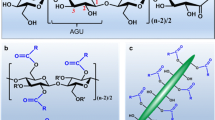Abstract
Hydrophobic cotton was achieved by surface modification of the cellulose with triglycerides from several plant oils including soybean, rapeseed, olive and coconut oils. These oils were delivered to the cellulose substrates in homogeneous solutions of ethanol or acetone as well as aqueous emulsions. Surface modification was facilitated by solvent evaporation followed by heating between 110 and 120 °C for 60 min. All oils, except for coconut, produced hydrophobic and less water-absorbing cotton, supporting the desirable role of higher unsaturation in the fatty acids to achieve crosslinked network. The most hydrophobic surfaces were obtained by the reaction with 1% soybean oil in acetone. On both bleached and scoured cotton, a water contact angle of 80° and water absorption value of 0.82 μL/mg were achieved. The acquired hydrophobicity was not only retained after water washing but also improved with subsequent exposures to elevated temperatures. The surface tension of scoured cotton cellulose was lowered from 63.81 mJ/m2 to 25.74 mJ/m2 when modified by soybean oil delivered in acetone, which is lower than that of poly(ethylene terephthalate). An aqueous emulsion of soybean oil also rendered the scoured cotton hydrophobic, which shows promise for a green chemistry and bio-based approach to achieve water repellency on cellulosic materials.









Similar content being viewed by others
References
Baiardo M, Frisoni G, Scandola M, Licciardello A (2002) Surface chemical modification of natural cellulose fibers. J Appl Polym Sci 83(1):38–45
Deschamps G, Caruel H, Borredon ME, Bonnin C, Vignoles C (2003) Oil removal from water by selective sorption on hydrophobic cotton fibers. 1. Study of sorption properties and comparison with other cotton fiber-based sorbents. Environ Sci Technol 37:1013–1015
Freytag R, Donze, J-J (1983) Alkali treament of cellulose fibers. In. Lewin M, Sello, SB Marcel-Dekkar (eds) Handbook of Fiber Sci & Tech: VI Chem Processing of Fibers and Fabrics, NY p 94–120
Fowkes FM, Riddle FL Jr, Pastore WE, Weber AA (1990) Interfacial interactions between self-associated polar liquids and squalane used to test equations for solid–liquid interfacial interactions. Colloids Surf 43:367–387
Gunstone FD, Hamilton R (eds) (2001) Oleochemical manufacture and applications. CRC Press, Boca Raton FL, pp 1–19
Heinze T, Liebert T (2001) Unconventional methods in cellulose functionalization. Prog Polym Sci 26:1689–1762
Hsieh Y-L (1995) Liquid transport in fabric structures. Text Res J 65(5):299–307
Jiang WC, Meng WD, Qing FL (2005) Synthesis of a novel perfluorooctylated polyacrylate and its application on cotton fabrics. J Appl Polym Sci 98(1):222–226
Kwok DY, Li D, Neumann AW (1994) Fowkes’ surface tension component approach revisited. Colloids Surf 89:181–191
Lee M, Nishi K, Jeong DS, Tokuyama T, Itazu T, Miyaji Y, Wakida T (2005) Change of surface characteristic of cotton and polyester fabrics treated with silicone resin by washing and subsequent heat treatment. Sen-I Gakkaishi 61(11):309–312
McCord MG, Hwang YJ, Qiu Y, Hughes LK, Bourham MA (2003) Surface analysis of cotton fabrics fluorinated in radio-frequency plasma. J Appl Polym Sci 88(8):2038–2047
Owens DK, Wendt RC (1969) Estimation of the surface free energy of polymers. J Appl Polym Sci 13:1741
Peydecastaing J, Girardeau S, Vaca-Garcia C, Borredon ME (2005) Long chain cellulose esters with very low DS obtained with non-acidic catalysts. Cellulose 13:95–103
Princi E, Vicini S, Pedemonte E, Mulas A, Franceschi E, Luciano G, Trefiletti V (2005) Thermal analysis and characterisation of cellulose grafted with acrylic monomers. Thermochimica Acta 425:173–179
Sato Y, Wakida T, Tokino S, Niu S, Ueda M, Mizushima H, Takekoshi S (1994) Effect of crosslinking agents on water repellency of cotton fabric treated with fluorocarbon resin. Text Res J 64(4):316–320
Sawatari C, Sekiguchi Y, Yagi T (1998) Durable water-repellent cotton fabrics prepared by low-degree substitution of long chain alkyl groups. Text Res J 68(7):508–514
Shimizu YI, Hayashi J (1989) Acylation of cellulose with carboxylic acids. Cell Chem Technol 23:661–670
Shukla SR, Gopala Rao GV, Athalye AR (1992) Mechanical and thermal behavior of cotton cellulose grafted with hydroxyethyl methacrylate using photoinitiation. J Appl Polym Sci 44:577–580
Talaba P, Srokova I, Hodul P, Ebringerova A (1996) New procedure for the preparation of cellulose esters with aromatic carboxylic acids. Chem Pap 50:365–368
Vaca-Garcia C, Thiebaud S, Borredon ME, Gozzelino G (1998) Cellulose esterification with fatty acids and acetic anhydride in lithium chloride/N,Ndimethylacetamide medium. JAOCS 75:315–319
Vaca-Garcia C, Gozzelino G, Glasser WG, Borredon ME (2003) Dynamic mechanical thermal analysis transitions of partially and fully substituted cellulose fatty eaters. J Polym Sci B 41:281–288
Yuen CWM, Li Y, Ku SK, Mak CM, Kan CW (2005) Experimental study on fabric water repellency using nanotechnology. AATCC Rev 5(8):41–45
Author information
Authors and Affiliations
Corresponding author
Rights and permissions
About this article
Cite this article
Dankovich, T.A., Hsieh, YL. Surface modification of cellulose with plant triglycerides for hydrophobicity. Cellulose 14, 469–480 (2007). https://doi.org/10.1007/s10570-007-9132-1
Received:
Accepted:
Published:
Issue Date:
DOI: https://doi.org/10.1007/s10570-007-9132-1




